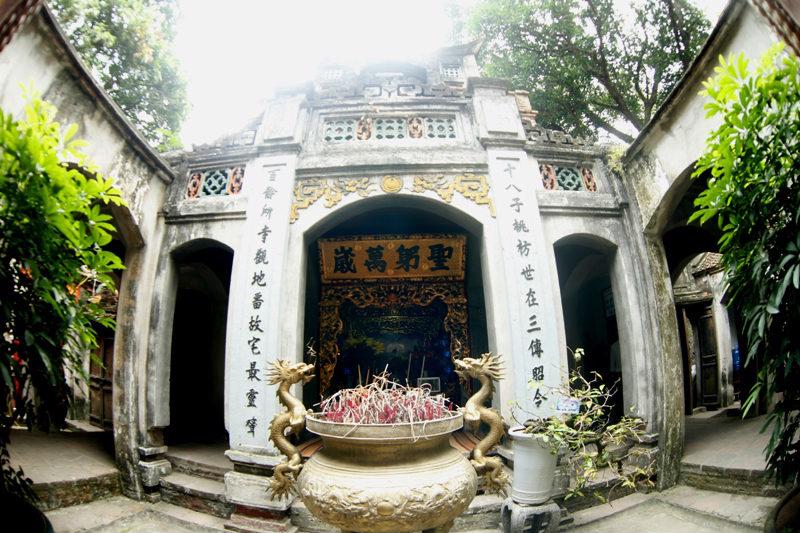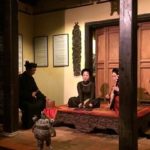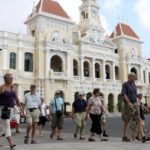Hanoi is proud to announce the upcoming launch of a culturally enriching tour. This exclusive experience will showcase the rich history and heritage of Empress-regent Y Lan, along with visits to nearby attractions including Bat Trang Pottery Village and Phu Dong Temple. Guests can look forward to immersing themselves in the wonders of these renowned destinations.
Ancient Pagoda Boasting Two National Treasures
| Ba Tam Pagoda in Duong Xa Commune of Gia Lam District, Hanoi. Photo: Hong Hanh |
Situated approximately 16 kilometers away from Hanoi’s city center, Ba Tam Temple relics and Pagoda cluster in Duong Xa Commune, Gia Lam District holds historical significance. This architectural marvel was erected in 1115 and serves as a tribute to the esteemed Empress-regent Y Lan (1044-1117).
The Festival of Ba Tam Pagoda and Temple is an annual event that honors the empress who valiantly ruled the kingdom during the absence of her spouse and son. This year, the festival coincided with the Duong Xa Tourism Week, which took place from March 5 to 12.
According to legend, Y Lan was born into a family engaged in the cultivation of mulberry trees, the rearing of silkworms, and the production of silk in the present-day Duong Xa Commune. As the esteemed concubine of King Ly Thanh Tong (1023-1072) and the mother of King Ly Nhan Tong (1066-1128), she is renowned for her significant contributions to the governance of the nation, ultimately leading to the prosperity of the Ly dynasty.
The Ba Tam Pagoda, constructed under the guidance of Empress-regent Y Lan, holds the distinction of being one of Vietnam’s most ancient pagodas. Situated on the outskirts of Hanoi, this thousand-year-old edifice boasts the honor of housing two of the 27 artifacts officially designated as “national treasures” in 2019.
| Ba Tam Temple in Gia Lam District. Photo: Hong Hanh |
Based on research conducted by domestic scholars, two significant artifacts have been identified as potential national treasures. The first artifact comprises a pair of lion statues dating back to the 12th century, while the second artifact is a golden gilded wooden altar from the 16th century. These artifacts fulfill three crucial criteria for national treasure recognition: they are original and one-of-a-kind, possess utmost cultural, historical, and artistic value, and are directly associated with a prominent figure of national significance, namely Empress-regent Y Lan.
The highlight of Ba Tam Pagoda features a grand Buddha altar adorned with a pair of majestic stone lions, standing at an impressive height of 1.2 meters and a width of 1.36 meters. Meticulously crafted from solid blue stone, these awe-inspiring lion statues showcase intricate details, capturing them in a humble kneeling pose.
The Chinese characters for “king” are prominently displayed on the foreheads of these majestic lions, symbolizing their total submission to Buddhism. Intricate carvings adorning the lions’ manes, ears, and mouths depict lightning and aura symbols, serving as a representation of Buddha’s powerful teachings.
The carved lines of the mascot display a gentleness and grace, showcasing the splendid nature of Vietnamese sculpture art during the 12th century. These masterpieces exude a sense of majesty, while still maintaining a warm and approachable allure.
The gilded wooden altar showcases the incredible skills of Vietnamese artisans from the 16th century, leaving viewers in awe of their craftsmanship.
The national treasure is intricately adorned with carvings of Vietnamese mythical creatures and flowers, including dragons, phoenixes, peacocks, pheasants, turtles, lotuses, and more.
| The two lion statues at Ba Tam Pagoda, Duong Xa Commune, Gia Lam District are among Vietnamese national treasures. Photo: Dan tri |
Furthermore, Ba Tam Pagoda boasts an impressive collection of ancient artifacts, including Ly Dynasty stone pillars, exquisite ceramics, mesmerizing stone crocodile statues, the renowned ‘jade’ well, and many more valuable treasures.
The pagoda has been adorned with four ancient steles, showcasing their historical significance from the post-Le era. Notably, among these is the 6th-year Duc Long stele dating back to 1635, as well as the 18th-year Bao Dai stele from 1943. These invaluable artifacts document the restoration dates of the pagoda and preserve its rich heritage.
The recent archaeological findings have confirmed the significant cultural and historical importance of Ba Tam Pagoda.
Recognizing the Importance of National Heritage
According to Mr. Tran Trung Hieu, Deputy Director of the Hanoi Tourism Department, Gia Lam District holds immense potential for the development of tourism. The district boasts three acclaimed urban attractions, namely the Duong Xa Relic site, Bat Trang Pottery Village, and Phu Dong Temple.
At the recently held conference on promoting Duong Xa commune as a tourist destination, Mr. [Name], the District Representative, emphasized the significance of showcasing the architectural beauty and cultural value of Ba Tam and Pagoda Relics Cluster in order to attract a greater number of tourists to Gia Lam District. This event was jointly organized by Gia Lam District and the Hanoi Department of Tourism.
| The sophisticated golden gilded wooden altar is recognized as a national treasure. Photo: Dan tri |
According to Le Hong Thai, the Director of HanoiTourist Co.Ltd, Gia Lam District is currently facing a lack of sufficient investment in the tourism industry. Particularly, there is a shortage in high-end hotels and experiential models that cater to international travelers.
“In the immediate future, it is crucial for the district to leverage the unique strengths of its existing cultural heritage, particularly the remarkable collection of artifacts tied to Empress-regent Y Lan,” he emphasized.
According to him, the incorporation of heritage education tours for young individuals can effectively amplify the significance of local antiquities while simultaneously fostering awareness and appreciation among the public.
Duong Xa Commune is home to a range of historically and culturally significant relics, including the renowned Ba Tam Pagoda and Temple. In addition to these notable sites, the commune also showcases 17 other relics of historical and cultural importance, five of which hold national classification.
Furthermore, Duong Xa Commune takes pride in its Thuan Quang traditional village, where agricultural products are skillfully processed. This village is known for producing 18 OCOP (One Commune One Product) items, including turmeric essential oil, turmeric starch, buffalo sausages, and more.
Experience smart cultivation at its finest at our 20-hectare orange farm in Duong Xa Commune. Visitors will have the opportunity to witness innovative farming techniques and explore the breathtaking beauty of our well-maintained orchards.
Gia Lam possesses numerous strengths in promoting tourism. However, conference participants believe that in order to further attract tourists, a more robust and impactful tourism policy is necessary.
| The image of a dragon head on an engraving at Ba Tam Pagoda. Photo: Dan tri |
“It is essential to establish links between three prominent tourist destinations: the Duong Xa Relic site, Bat Trang Pottery Village, and Phu Dong Temple,” stated Hieu. “This connection forms the foundation for travel businesses to curate enticing tours and attract visitors to the area,” he further emphasized.
According to Pham Duy Nghia, director of Vietfoot Travel, it is important for Gia Lam to broaden its range of tourism offerings.
“The local tourism authority should consider offerings such as cycling tours that allow visitors to explore nature while also visiting cultural relics. Additionally, combining a visit to Ocean Park’s urban area for shopping and dining with a trip to nearby handicraft villages would provide a unique and enriching experience for tourists,” he suggested.
With the close collaboration between local government and tourism service providers, we anticipate the development of a wider range of exciting tours to Gia Lam District that cater to the diverse needs of both domestic and international tourists.
Ancient house in Ma May
NDO – Ma May, a rare quarter that still retains several old houses, has created one of the characteristics of Hanoi. Hanoi’s streets are becoming increasingly crowded and traditional features can sometimes be hidden behind modern life. But if one takes the time to relax and look around, the ancient features begin to reveal themselves.














